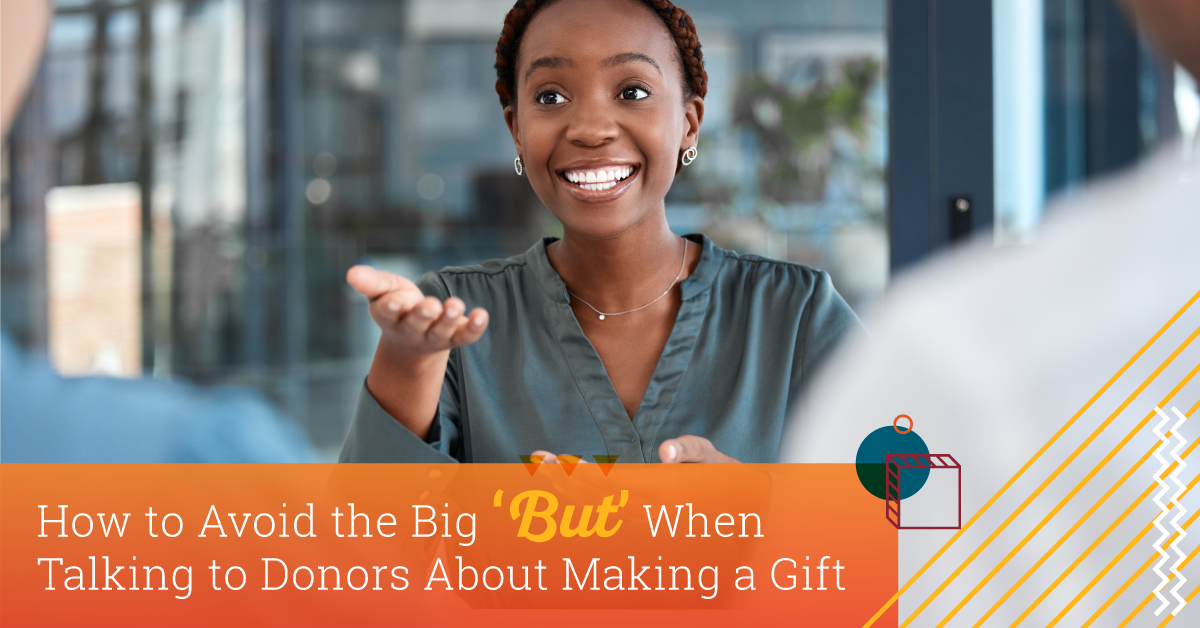Have you ever been meeting with a prospect, feeling confident that if you finally make the ask, they’ll make the gift? You take the leap…and you get a… no. You’re left wondering, “But why?”
Funny thing about the word “but.” It often goes hand in hand with the “no.” When you hear it, you’ll know you’re in trouble. But—you can recover! Here are some ways to avoid the but, work with it, and move the conversation forward.
A Mental Eraser
It’s a small but powerful word, but. A chameleon in the English language that fits slyly into sentences. “It acts like a mental eraser, and it often buries whatever you’ve said before it,” says Dianna Booher, communications consultant and author. “It makes communication spiral down instead of spin up.”
Perhaps you’ve heard statements like these:
“The work your nonprofit does is important, but I don’t have the assets to leave a gift.”
“I want to make a gift, but I have other things to consider right now.”
“I appreciate your time explaining the needs of ABC nonprofit, but I’m not able to help out with a gift at this time.”
Avoid the “but” with this mindset prep if a “no” or “not right now” situation occurs.
- Remember, it’s not about you. They’re saying no to the gift, not to you personally. Their answer is most likely related to what’s going on in their world—maybe an uncertain financial future, or where they are in their donor journey.
TIP: Assess the stressors or life events that may be occurring in this person’s life that could delay or derail their planned gift. You may need to take a step back in the donor journey and start again from a place that better matches where they are. - Commend their spark to give. Keep in mind that your prospect connected with you because they felt an intuitive drive to align with your nonprofit. Tap into that again because their actions tell you they want to support your organization. They just need a steady hand to show them the way.
- Maintain compassion. Empathy is essential in overcoming objections. Bloomerang offers an “empathy formula” with a feel, felt, found flow:
- I understand exactly how you feel. This statement lets the donor know that you’ve heard them and are reflecting on their opinion.
- I know other donors who have felt similarly. Scale the conversation and build comfort—you’ve been in this conversation before!
- Until they found out. Bring up information, results, a success story or other content that answers the donor’s concern and moves the conversation forward. Again, you’ve been here before!
TEMPER YOUR DEFENSE: This Psychology Today article offers graceful ways to cope with defensiveness. One example: In the moment, buy time.
Use ‘And’ to Avoid ‘But’-ting Heads
Let’s say you met with a prospect a few weeks ago and left with their commitment to make a planned gift. However, in a subsequent meeting, “after some thinking,” they have decided they just can’t commit to it. If you respond by saying, “But, I thought we had already discussed this,” you’re putting them on high alert to feel defensive about their decision.
Choose “and” instead of “but.”
“And” invites further discussion without negating what the other person said. So, you might respond, “I understand this is an important decision, and I want to be sure to completely address any of your concerns because, after the last meeting, I thought we were in agreement.”
Other examples:
“I understand what you’re saying, and I can put you in touch with an estate planning attorney.”
“Your reasons make sense, and I’d like to introduce you to a donor who could share their giving story to help you see how easily they created a gift through a beneficiary designation.”
“Yes, I understand, and there are ways to make sure you are able to leave a legacy and gain a source of income to benefit you or your loved ones if that’s important to you.”
By using “and” you legitimize their reason for saying no and show a solution and a way forward.
4 More Ways to Respond to Objections
- Clarify their objection. Make sure you understand their root concern for deciding not to make a planned gift. Repeat and reframe until you’re in sync.
- Match your response to the objection. This goes back to listening and the importance of agility in the conversation (no single script will do). Is the prospect worried about your financial soundness? A look at your nonprofit’s financial numbers will help. Do they need a third party to validate the estate gift process? Set up a meet-and-greet with a legacy donor so your prospect can talk to them, hear their giving story and hopefully begin to see them as a legacy-giving mentor.
- Ask a question to move the conversation from a stall to starting forward again. An objection can feel like a dead end. It’s most often just a pause or subtle request for more information or reassurance.
- Remind the prospect of their importance in your organization’s work. Speak to the specific value of your organization’s mission and its impact on the people, community and world you serve. Talk about the present-day situation you’re seeking to change. Fundraising expert Jeff Brooks says to share details, not generalizations: “Very few donors are interested in simply funding an organization. They want to do something specific.”
If a prospect objected to making a planned gift, how did you keep moving the conversation forward? Was it an “and” or “but” moment?

